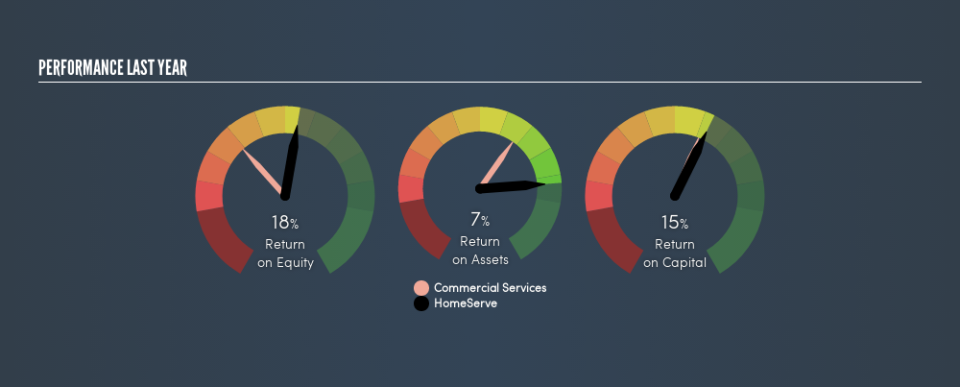Is HomeServe plc’s (LON:HSV) 15% ROCE Any Good?

Want to participate in a research study? Help shape the future of investing tools and earn a $60 gift card!
Today we are going to look at HomeServe plc (LON:HSV) to see whether it might be an attractive investment prospect. In particular, we'll consider its Return On Capital Employed (ROCE), as that can give us insight into how profitably the company is able to employ capital in its business.
Firstly, we'll go over how we calculate ROCE. Next, we'll compare it to others in its industry. And finally, we'll look at how its current liabilities are impacting its ROCE.
What is Return On Capital Employed (ROCE)?
ROCE measures the 'return' (pre-tax profit) a company generates from capital employed in its business. In general, businesses with a higher ROCE are usually better quality. Ultimately, it is a useful but imperfect metric. Renowned investment researcher Michael Mauboussin has suggested that a high ROCE can indicate that 'one dollar invested in the company generates value of more than one dollar'.
So, How Do We Calculate ROCE?
Analysts use this formula to calculate return on capital employed:
Return on Capital Employed = Earnings Before Interest and Tax (EBIT) ÷ (Total Assets - Current Liabilities)
Or for HomeServe:
0.15 = UK£136m ÷ (UK£1.4b - UK£503m) (Based on the trailing twelve months to September 2018.)
So, HomeServe has an ROCE of 15%.
See our latest analysis for HomeServe
Is HomeServe's ROCE Good?
One way to assess ROCE is to compare similar companies. HomeServe's ROCE appears to be substantially greater than the 10% average in the Commercial Services industry. I think that's good to see, since it implies the company is better than other companies at making the most of its capital. Independently of how HomeServe compares to its industry, its ROCE in absolute terms appears decent, and the company may be worthy of closer investigation.
When considering ROCE, bear in mind that it reflects the past and does not necessarily predict the future. ROCE can be misleading for companies in cyclical industries, with returns looking impressive during the boom times, but very weak during the busts. This is because ROCE only looks at one year, instead of considering returns across a whole cycle. What happens in the future is pretty important for investors, so we have prepared a free report on analyst forecasts for HomeServe.
HomeServe's Current Liabilities And Their Impact On Its ROCE
Short term (or current) liabilities, are things like supplier invoices, overdrafts, or tax bills that need to be paid within 12 months. Due to the way the ROCE equation works, having large bills due in the near term can make it look as though a company has less capital employed, and thus a higher ROCE than usual. To counter this, investors can check if a company has high current liabilities relative to total assets.
HomeServe has total assets of UK£1.4b and current liabilities of UK£503m. As a result, its current liabilities are equal to approximately 36% of its total assets. With this level of current liabilities, HomeServe's ROCE is boosted somewhat.
Our Take On HomeServe's ROCE
While its ROCE looks good, it's worth remembering that the current liabilities are making the business look better. Of course you might be able to find a better stock than HomeServe. So you may wish to see this free collection of other companies that have grown earnings strongly.
If you like to buy stocks alongside management, then you might just love this free list of companies. (Hint: insiders have been buying them).
We aim to bring you long-term focused research analysis driven by fundamental data. Note that our analysis may not factor in the latest price-sensitive company announcements or qualitative material.
If you spot an error that warrants correction, please contact the editor at editorial-team@simplywallst.com. This article by Simply Wall St is general in nature. It does not constitute a recommendation to buy or sell any stock, and does not take account of your objectives, or your financial situation. Simply Wall St has no position in the stocks mentioned. Thank you for reading.

 Yahoo Finance
Yahoo Finance 
